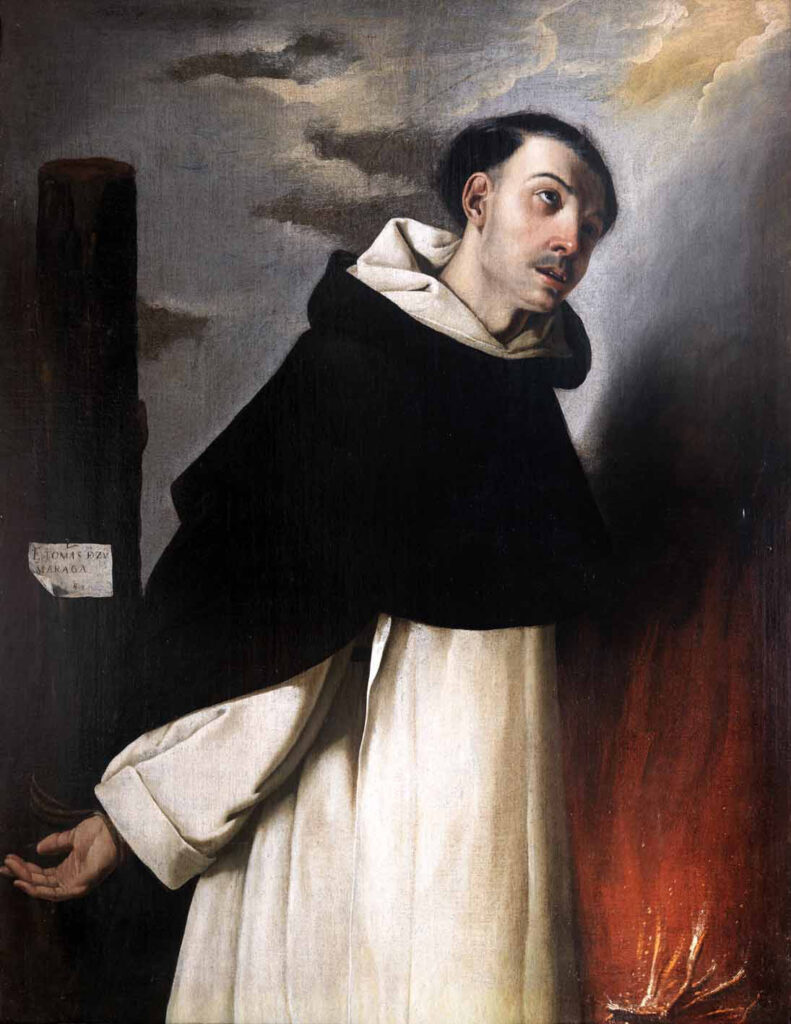dominican saints
Bl. Thomas of Zumárraga & Companions, M.M.O.P.
Feast Day September 12th

Born: March 5, 1577 in Vitoria
Died: May 15, 1450 at Aix-en-Provence, France of natural causes; buried in the Church of the Magdalen; his tomb became known as a site of miraculous cures.
Beatified: May 7, 1867 (cultus confirmed) by Pope Pius IX
Thomas was born on March 9, 1577, in Vitoria, the Capital of Alava Province in Spain, and baptized on the following day. He received his early education in the towns where he lived alternately: Vitoria, Salinas, and Léniz. At age 16, he entered the Priory of St. Dominic in Vitoria and made profession on January 19, 1594. He was then transferred to the College of St. Gregory in Valladolid, to complete his priestly education. In 1600, when only 23 years old, he was ordained priest.
While continuing his studies at St. Gregory, he volunteered to go to the Far East as missionary. In 1601, he left for Manila via Mexico and arrived there on April 30, 1602. The Provincial Chapter, in session when he arrived, immediately directed him to go found a new mission in Japan.
On June 1, 1602, Thomas sailed from Manila with four companions, under the leadership of the Vicar-Provincial, Father Francis Morales. One month later, on July 3, they disembarked at the small village of Nagahama, located on the small archipelago of Koshiki, just to the northwest of Satsuma [Kagoshima].
On November 28, Father Zumárraga was sent to Manila to inform the Superiors about the progress of the new foundation. He failed to reach them, however, because the ship he was on was forced by storms to land in Cochin-China. When he finally returned to Japan in September 1603, he took time to aid those persons infected with the plague on a Japanese ship.
In early October of 1605, Thomas was sent to Kyoto, the imperial capital, there to found a church. It proved impossible, however, for him to start a foundation during the political turmoil of the time. Accordingly, he stayed with Father Mena for a month and helped in attending the needs of the Christians of Omura and Hirado in the province of Nagasaki.
In 1606, Father Zumárraga was named Superior of the Dominican House in Kyodomari, the port of the actual city of Sendai, in the province of Kagoshima. His apostolate there was very fruitful.
In April 1608, he went to Manila to take part in the Provincial Chapter, remaining there until July 1609, then returned to Japan.
After spending several months in the mission of Hizen in Saga, he was assigned to Our Lady of the Rosary in Miyako, Kyoto. Under the leadership of his Superior, Father Joseph Salvanés, he continued to work energetically among the people until the middle of October 1613. It was then that a sweeping anti-Christian persecution broke out, forcing the missionaries to retreat to Nagasaki.
The infamous decree prohibiting Christianity and expelling all missionaries from Japan was published on January 27, 1614. Two months later, Father Zumárraga was named Vicar-Provincial over all the Dominicans in Japan. That spring, he was one of the missionaries who promoted and guided the widely-acclaimed religious movement in Nagasaki. When the missionaries were finally exiled in November 1614, he managed to stay in Japan — in hiding — so as to continue ministering to the persecuted.
In the summer of 1615, Zumárraga was relieved of his responsibility as Vicar-Provincial, and assigned to Kyoto to help Fr. Salvanés, who had fallen sick. While there, he set up a hospice for the missionaries in neighboring Fushimi. Soon, the persecution began to create havoc in that region also, forcing him to return to Nagasaki in March of 1617. In June, he went to the region of Omura to carry out his ministry among the local Christians; these were very fervently living their faith, following the example of their recently martyred missionaries. Soon, he and a group of catechists and other helpers became completely exhausted from working day and night. Zumárraga was finally arrested on July 23, 1617, and imprisoned in Suzuta, Omura. evertheless, he continued his apostolic ministry from prison, where he remained for five years.
On September 12, 1622, Father Zumárraga and seven other Christians were burned alive in Hokobaro, Omura. He was declared by Pope Pius IX on May 7, 1867.
Prayers/Commemorations
First Vespers
Ant. The souls of the Saints, who have followed the footsteps of Christ, rejoice in heaven: and because they have shed their blood for love of Him, they shall reign forever with Christ.
V. Pray for us, Blessed N. with your Companions (Alleluia).
R. That we may be made worthy of the promises of Christ (Alleluia).
Lauds
Ant. These are the Saints, who, for the love of God, despised the threats of men. The holy Martyrs rejoice with the Angels in heaven. O how precious is the death of the Saints who continuously stand before the Lord and are never separated from one another.
V. God is wonderful (Alleluia).
R. In his Saints (Alleluia).
Second Vespers
Ant. God will wipe away every tear from the eyes of the Saints, and then there will be no more mourning nor clamour, nor any sorrow, for the former things have passed away.
V. Pray for us, Blessed N. with your Companions (Alleluia).
R. That we may be made worthy of the promises of Christ (Alleluia).
Prayer:
Let us Pray: O God, who didst enable Blessed(N.), Thy Confessor, to preach the gospel of peace by word and deed, make us, we beseech Thee through his intercession, to receive Thy law with a perfect heart and fulfill it by holy deeds. Through Christ our Lord. Amen.